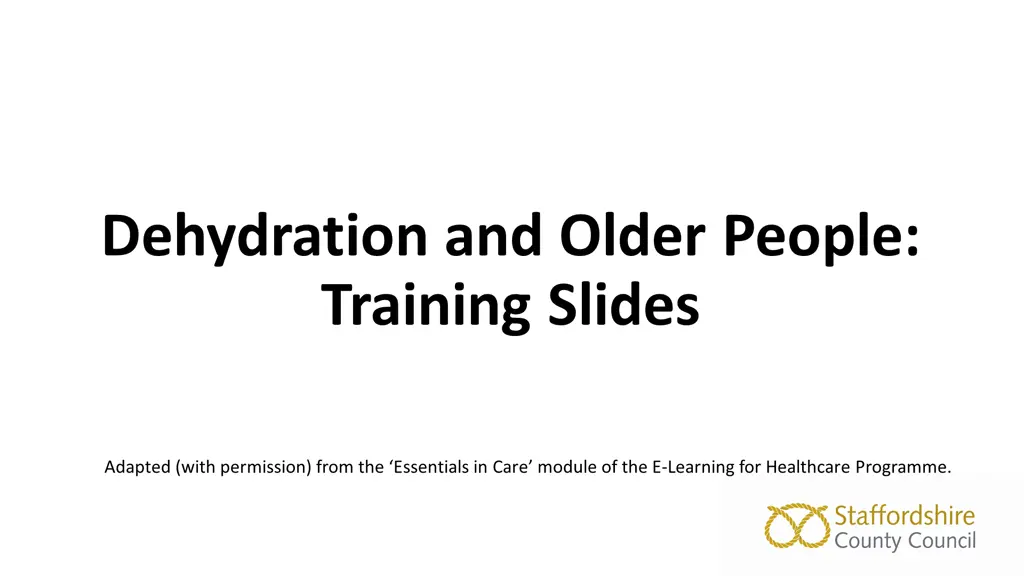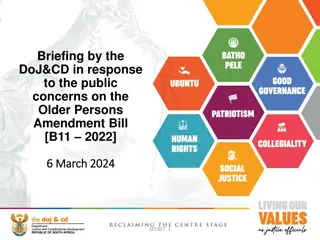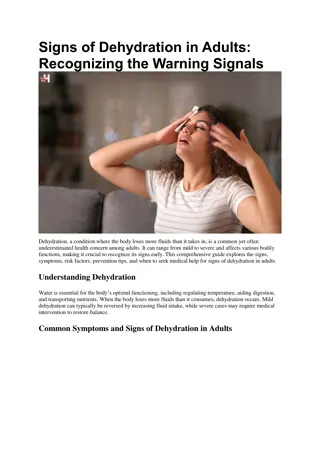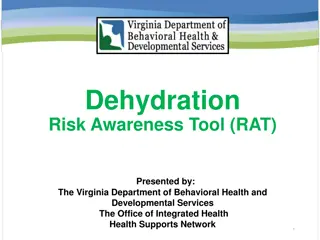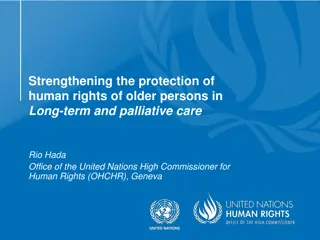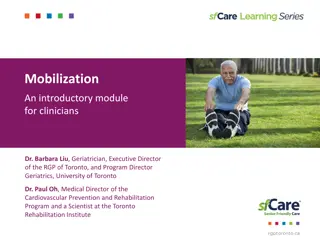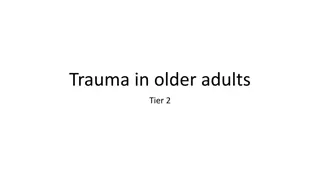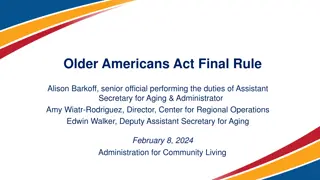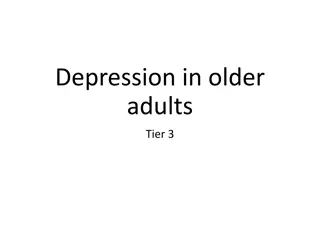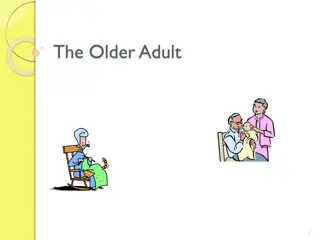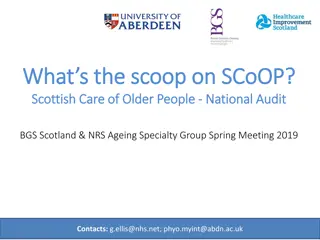Dehydration and Older People: Training Slides
Training slides adapted from the Essentials in Care module of the E-Learning for Healthcare Programme on dehydration in older people, covering the risks, signs, prevention, and the role of water.
Download Presentation

Please find below an Image/Link to download the presentation.
The content on the website is provided AS IS for your information and personal use only. It may not be sold, licensed, or shared on other websites without obtaining consent from the author.If you encounter any issues during the download, it is possible that the publisher has removed the file from their server.
You are allowed to download the files provided on this website for personal or commercial use, subject to the condition that they are used lawfully. All files are the property of their respective owners.
The content on the website is provided AS IS for your information and personal use only. It may not be sold, licensed, or shared on other websites without obtaining consent from the author.
E N D
Presentation Transcript
Dehydration and Older People: Training Slides Adapted (with permission) from the Essentials in Care module of the E-Learning for Healthcare Programme.
Covering: What is dehydration Why older people are more at risk of dehydration Common signs and symptoms of dehydration How to prevent dehydration Daily living equipment and technology that can help with drinking
Dehydration: We are hydrated when we have enough fluid (water) in our body to be able to function properly. Dehydration happens when our body loses more fluid (water) than we take in.
The role of water: The human body cannot function without water. A person can survive up to 50 days without food. But can only survive a few days without water!
Why do we need water? Activity: Think about why our bodies need water. Feedback.
What water does to the body: Regulates (controls) body temperature (by sweating and breathing). Lubricates joints (keeping them moving freely). Dissolves nutrients and minerals for the body to use. Carries nutrients and oxygen around the body. Prevents constipation. Protects the body s organs (like the brain, eyes and spinal cord). Moistens tissues in the eyes, nose and mouth. Helps with digestion. Flushes out waste products through urine and faeces (going to the toilet).
Why older people are more at risk of dehydration: As we age, our sense of thirst becomes less sensitive and less accurate. So older people should not just rely on thirst as a signal of when and how much to drink. As we get older, our bodies find it harder to respond to changes in temperature (such as very hot weather). Certain illnesses like diabetes and kidney disease can also increase our risk of dehydration.
Storing water in our bodies: Most of the body s water is stored in muscle (about 75% of it). But as we age, we lose muscle mass (the amount of muscle we have). This means that older people cannot store as much water in their muscles as they once did (only about 45% of it). Less muscle = Less water storage = Greater risk of dehydration!
How do we lose water from our bodies? Activity: Think about the different ways that we lose water from our bodies. Feedback.
Losing water from our bodies: Water is constantly being lost from our bodies through: Dehydration happens when the body loses more water than it takes in.
What are the common signs and symptoms of dehydration? Activity: Sort the list of symptoms into 3 categories: - Mild dehydration - Moderate dehydration - Severe dehydration Feedback
Common signs and symptoms of dehydration: Mild Dehydration Moderate Dehydration Severe Dehydration Thirsty Dizzy or light-headed Confusion Tired Lacks concentration or can t think clearly Lack of balance/ co-ordination/unsteadiness Concentrated urine (dark yellow or strong smelling wee) Forgetfulness or short-term memory loss Cold hands and feet Urinate less often and only produce small amounts of wee Loss of strength or stamina Rapid heart rate Headache Dry lips and mouth Weak pulse/low blood pressure Irritable Dry eyes that are unable to produce tears Seizures (fits) Sunken eyes Loss of consciousness Dry skin that sags slowly back when pinched Death
Checking for dehydration: Hydrated The Healthy Wee Chart is a simple guide that people can use to work out how hydrated they are. The aim is for a pale, clear colour. Dark yellow wee means that someone is dehydrated, so they need to drink more to rehydrate. Dehydrated
Common worries about drinking more: Worried about incontinence If a person limits the amount they drink, it could make incontinence worse, as it reduces the bladder s capacity (how much it can hold). Worried about needing the toilet in the night People should try to increase their fluid intake during the day.
How to prevent dehydration: Adults (regardless of age or size), need to drink at least 1.5 litres of fluid per day, to function properly. Fluid can include: water, milk, juices, soft drinks, soup, tea and coffee.
So how much is 1.5 litres? Activity: Guess how many cups/glasses you can fill with 1.5 litres. Feedback.
Preventing dehydration in older people: Most of the body s water is stored in muscle. But older people have less muscle to store their water in. So older people should drink little, but often. This is better than a few larger drinks throughout the day (which can t be stored as well, due to less storage capacity). Less muscle = Less water storage = Greater risk of dehydration!
Ways to encourage older people to drink more: Get creative! Offer different types of drinks e.g. squash, coffee, tea (including herbal tea), fruit juice, soup, hot chocolate and milkshakes. Vary between hot and cold drinks. Try new flavours. Add soda water to make drinks bubbly. Ice and a slice? Try adding ice cubes and a slice of lemon or lime. If people are struggling to drink a lot, then offer foods with a high water content e.g. gravy, jelly, ice lollies, custard or fruit like melon.
Ways to encourage older people to drink more: Make drinking easy! Always have drinks available at mealtimes. Use a brightly coloured cup to draw attention. Or a clear glass so it s easy to see what s inside. Offer the person the cup. And put it where they can easily reach it. Make sure cups or glasses are easy to use not too heavy or a difficult shape. Use helpful equipment, like one cup kettles or kettle tippers, to help people to stay independent.
Daily living equipment and technology to help with drinking: Daily living equipment and technology can help people to keep their independence. There are lots of affordable products out there that can really help. Some things can even be bought from supermarkets or high street shops. Staffordshire County Council s Happy at Home webpage gives information on daily living equipment and technology. On the Interactive House , click on the Kitchen , which includes a section on Drinking preparation .
Examples of daily living equipment and technology to help with drinking:
